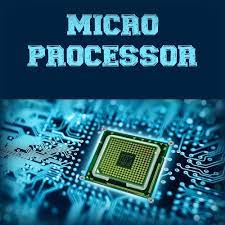Microprocessor is a computer processor where the data processing logic and control is included on a single integrated circuit, or a small number of integrated circuits. The microprocessor contains the arithmetic, logic, and control circuitry required to perform the functions of a computer’s central processing unit.
The integrated circuit is capable of interpreting and executing program instructions and performing arithmetic operations. The microprocessor is a multipurpose, clock-driven, register-base, digital integrate circuit that accepts binary data as input, processes it according to instructions store in its memory, and provides results (also in binary form) as output. Microprocessors contain both combinational logic and sequential digital logic, and operate on numbers and symbols represented in the binary number system.
The integration of a whole CPU onto a single or a few integrated circuits using Very-Large-Scale Integration (VLSI) greatly reduced the cost of processing power. Integrated circuit processors are produce in large numbers by highly automate metal-oxide-semiconductor (MOS) fabrication processes, resulting in a relatively low unit price. Single-chip processors increase reliability because there are much fewer electrical connections that could fail. As microprocessor designs improve, the cost of manufacturing a chip (with smaller components built on a semiconductor chip the same size) generally stays the same according to Rock’s law.
Before microprocessors, small computers had built using racks of circuit boards with many medium- and small-scale integrated circuits, typically of TTL type. Microprocessors combined this into one or a few large-scale ICs. The first commercially available microprocessor was the Intel 4004.
How do microprocessors work?
The microprocessor follows a sequence: Fetch, Decode, and then Execute. The microprocessor fetches those instructions from the memory, then decodes it and executes those instructions till STOP instruction is reach. Later, it sends the result in binary to the output port.
What is the use of microprocessor?
General-purpose microprocessors in personal computers are use for computation, text editing, multimedia display, and communication over the Internet.
How do I choose a microprocessor?
- Make a list of required hardware interfaces.
- Examine the software architecture.
- Select the architecture.
- Identify Memory Needs.
- Start searching for microcontrollers.
- Examine Costs and Power Constraints.
- Check part availability.
Why is it called a microprocessor?
It is call because this device comprises of transistors which are small in size (micro-meter). The word micro is use in electronics and in science generally, to mean One-millionth or 10^-6. It has also used to denote something very small like a very small processor or microprocessor.
Is Raspberry Pi 4 a microcontroller or microprocessor?
The Raspberry Pi is not a microcontroller but is a microprocessor instead. It is larger than the average microcontroller, uses more power, has a clock speed of between 700MHz-1.5GHz, and a RAM of between 1-8GB. Also, the Raspberry Pi, unlike microcontrollers, can run both 32-bit and 64-bit.
Is Arduino a microprocessor?
Arduino (/ɑːrˈdwiːnoʊ/) is an open-source hardware and software company, project, and user community that designs and manufactures single-board microcontrollers and microcontroller kits for building digital devices. Arduino board designs use a variety of microprocessors and controllers.
Which microcontroller is best?
- 1: Groboards Giant Board. (Image credit: Grobaords)
- 2: Seeeduino XIAO. (Image credit: Seeed Studio)
- 3: The BBC micro:bit V2. (Image credit: micro:bit)
- 4: Adafruit Gemma M0. (Image credit: Adafruit Industries)
- 5: Arduino Uno Rev3. (Image credit: Arduino)
Why it is called 8085 microprocessor?
The word length of a processor depends on data bus, that’s why Intel 8085 is call as 8 bit Microprocessor because it have an 8 bit data bus. Control Bus: Microprocessor uses control bus to process data that is what to do with the selected memory location. Some control signals are Read, Write and Opcode fetch etc.
Is Raspberry Pi a SoC?
As for the specifications, the Raspberry Pi is a credit card-size computer power by the Broadcom BCM2835 system-on-a-chip (SoC). This SoC includes a 32-bit ARM1176JZFS processor, clocked at 700MHz, and a Videocore IV GPU. It also has 256MB of RAM in a POP package above the SoC.
Which language is used in Arduino?
The Arduino IDE supports the languages C and C++ using special rules of code structuring. The Arduino IDE supplies a software library from the Wiring project, which provides many common input and output procedures.





